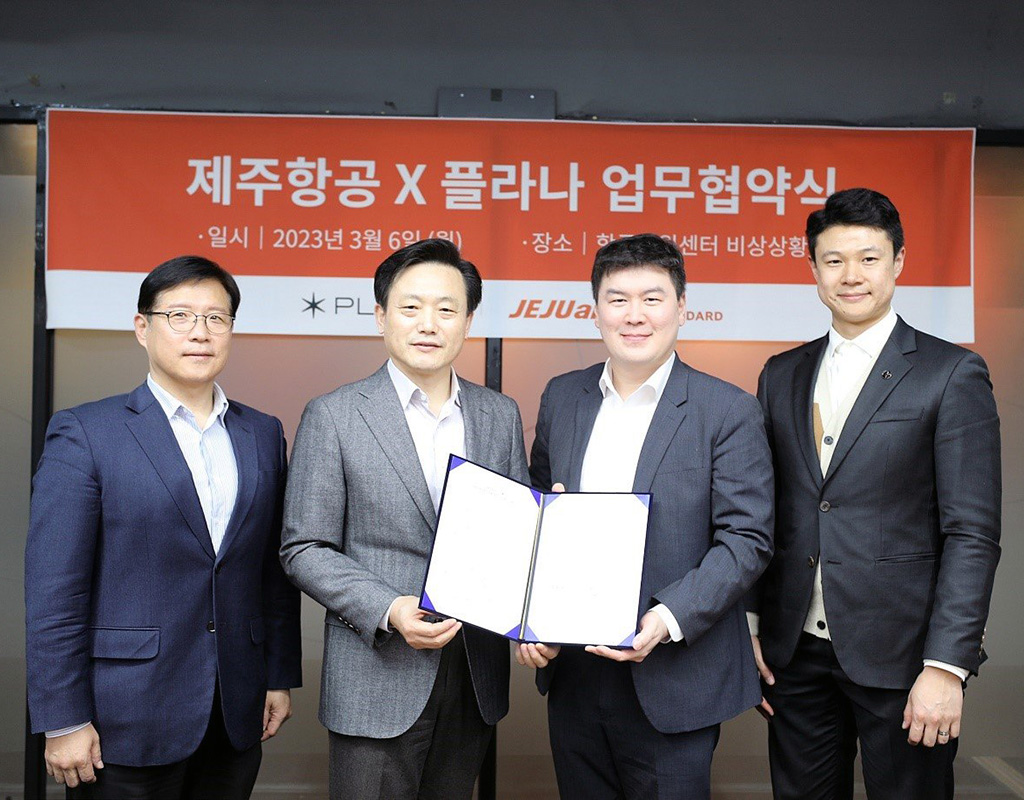
PLANA (CEO Braden J. Kim), a company developing Hybrid Electric Vertical Takeoff and Landing (HeVTOL) aircraft in South Korea, announced on March 6th that it has signed a Memorandum of Understanding (MoU) with Jeju Air to collaborate on creating an Advanced Air Mobility (AAM) ecosystem.
Under the terms of the MoU, PLANA, a hybrid AAM aircraft developer in South Korea, and Jeju Air, a leader in the LCC industry in South Korea, have set a policy to establish a cooperation system for the first phase of the Korean Urban Air Mobility (K-UAM) Grand Challenge, conducted by the Ministry of Land, Infrastructure, and Transport in the second half of this year, aiming to discover and develop business models to create an AAM ecosystem.
Both companies will also actively collaborate on AAM-related Air Operator Certificate (AOC) qualification standards and the training of industry workers including pilots.
AAM stands for Advanced Air Mobility, a broad concept that includes Urban Air Mobility (UAM), Regional Air Mobility (RAM), and more.
To commercialize AAM, it is essential to create an ecosystem of related companies that not only develop airframes, but also simulate and verify the entire process from flight preparation to termination, such as flight systems, vertiports (Vertical Takeoff and Landing Aircraft Transport Area), and 5G/LTE airspace networks.
As a company that aspires to move beyond UAM and become a major player in the domestic and global AAM market, Braden J. Kim, CEO of PLANA, said, “It is imperative that we collaborate with Jeju Air, a leader in the LCC business in Korea, to create an AAM ecosystem. Through the collaboration with Jeju Air, we will be able to provide clients the unique experience of long-distance flying services with over 500 kilometers flight range, which has become PLANA AAM’s competitive edge.”
“As an air carrier, we will discover a stable business model based on our know-how and knowledge of aviation management,” said Kim E-bae, CEO of Jeju Air. “In particular, the MoU with PLANA, that is developing hybrid AAM, is a process for Jeju Air to expand its business model beyond UAM to AAM.”
At the recent Drone Show Korea, PLANA had an exclusive 120-square-meter booth and was the first to exhibit the scaled-down airframe of the AAM. The AAM can fly over 500 kilometers at a cruising speed of 300 km/h and a maximum speed of 350 km/h while carrying one pilot and four to six passengers. It uses next-generation Sustainable Aviation Fuel (SAF), which reduces carbon dioxide emissions by more than 80% when compared to conventional helicopters.
In addition, PLANA intends to demonstrate the first flight of a pure battery-based scale model aircraft later this year. In order to collaborate closely with FAA certification authorities, PLANA plans to open a branch office in the United States this year, aiming to commercialize its certified aircraft in 2028. The company will take part in the Grand Challenge demonstration project conducted by the Ministry of Land, Infrastructure, and Transport later this year.
(CEO Braden J. Kim), a company developing Hybrid Electric Vertical Takeoff and Landing (HeVTOL) aircraft in South Korea, announced on March 6th that it has signed a Memorandum of Understanding (MoU) with Jeju Air to collaborate on creating an Advanced Air Mobility (AAM) ecosystem.
Under the terms of the MoU, PLANA, a hybrid AAM aircraft developer in South Korea, and Jeju Air, a leader in the LCC industry in South Korea, have set a policy to establish a cooperation system for the first phase of the Korean Urban Air Mobility (K-UAM) Grand Challenge, conducted by the Ministry of Land, Infrastructure, and Transport in the second half of this year, aiming to discover and develop business models to create an AAM ecosystem.
Both companies will also actively collaborate on AAM-related Air Operator Certificate (AOC) qualification standards and the training of industry workers including pilots.
AAM stands for Advanced Air Mobility, a broad concept that includes Urban Air Mobility (UAM), Regional Air Mobility (RAM), and more.
To commercialize AAM, it is essential to create an ecosystem of related companies that not only develop airframes, but also simulate and verify the entire process from flight preparation to termination, such as flight systems, vertiports (Vertical Takeoff and Landing Aircraft Transport Area), and 5G/LTE airspace networks.
As a company that aspires to move beyond UAM and become a major player in the domestic and global AAM market, Braden J. Kim, CEO of PLANA, said, “It is imperative that we collaborate with Jeju Air, a leader in the LCC business in Korea, to create an AAM ecosystem. Through the collaboration with Jeju Air, we will be able to provide clients the unique experience of long-distance flying services with over 500 kilometers flight range, which has become PLANA AAM’s competitive edge.”
“As an air carrier, we will discover a stable business model based on our know-how and knowledge of aviation management,” said Kim E-bae, CEO of Jeju Air. “In particular, the MoU with PLANA, that is developing hybrid AAM, is a process for Jeju Air to expand its business model beyond UAM to AAM.”
At the recent Drone Show Korea, PLANA had an exclusive 120-square-meter booth and was the first to exhibit the scaled-down airframe of the AAM. The AAM can fly over 500 kilometers at a cruising speed of 300 km/h and a maximum speed of 350 km/h while carrying one pilot and four to six passengers. It uses next-generation Sustainable Aviation Fuel (SAF), which reduces carbon dioxide emissions by more than 80% when compared to conventional helicopters.
In addition, PLANA intends to demonstrate the first flight of a pure battery-based scale model aircraft later this year. In order to collaborate closely with FAA certification authorities, PLANA plans to open a branch office in the United States this year, aiming to commercialize its certified aircraft in 2028. The company will take part in the Grand Challenge demonstration project conducted by the Ministry of Land, Infrastructure, and Transport later this year.
This press release was prepared and distributed by PLANA.

